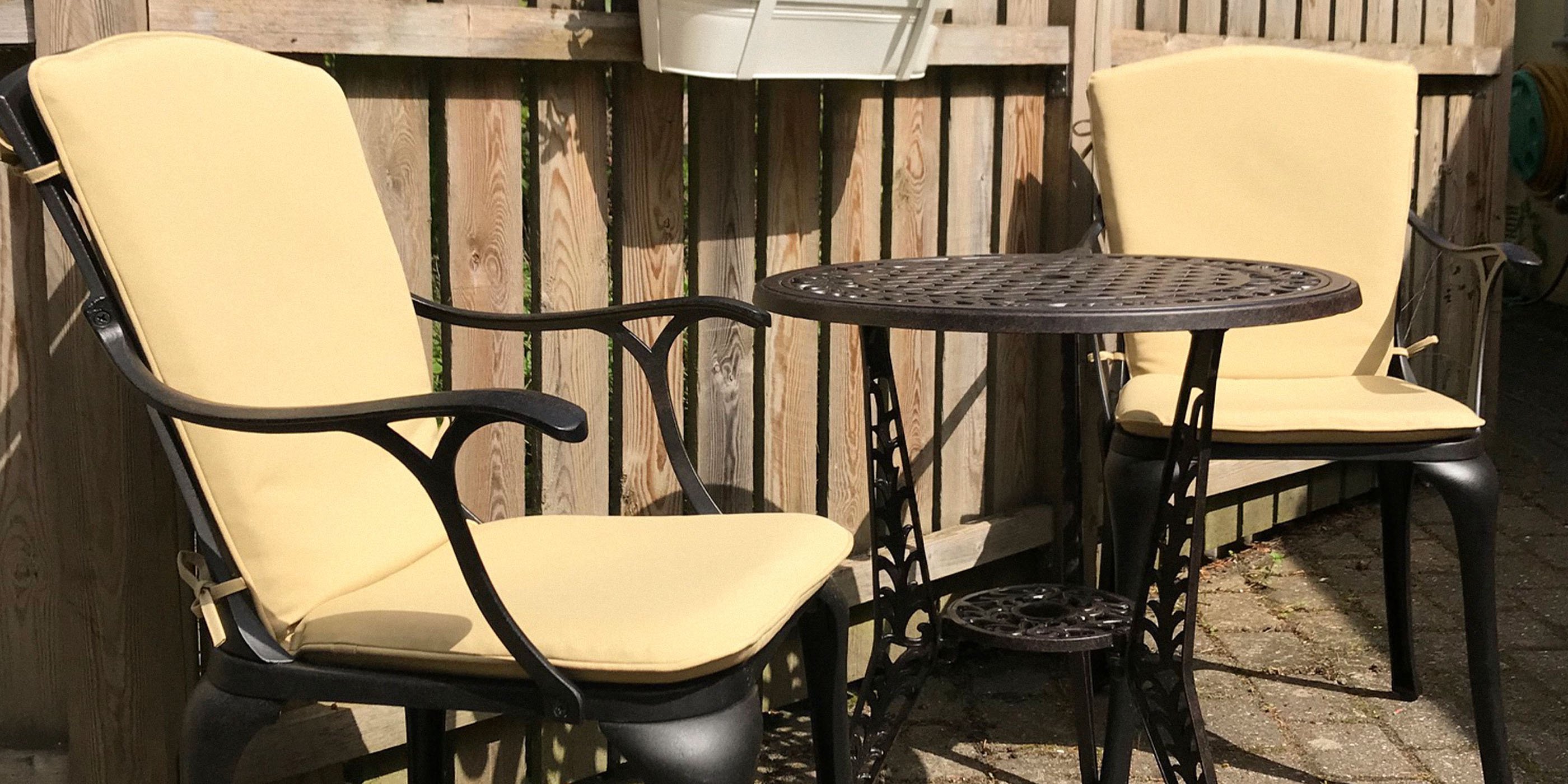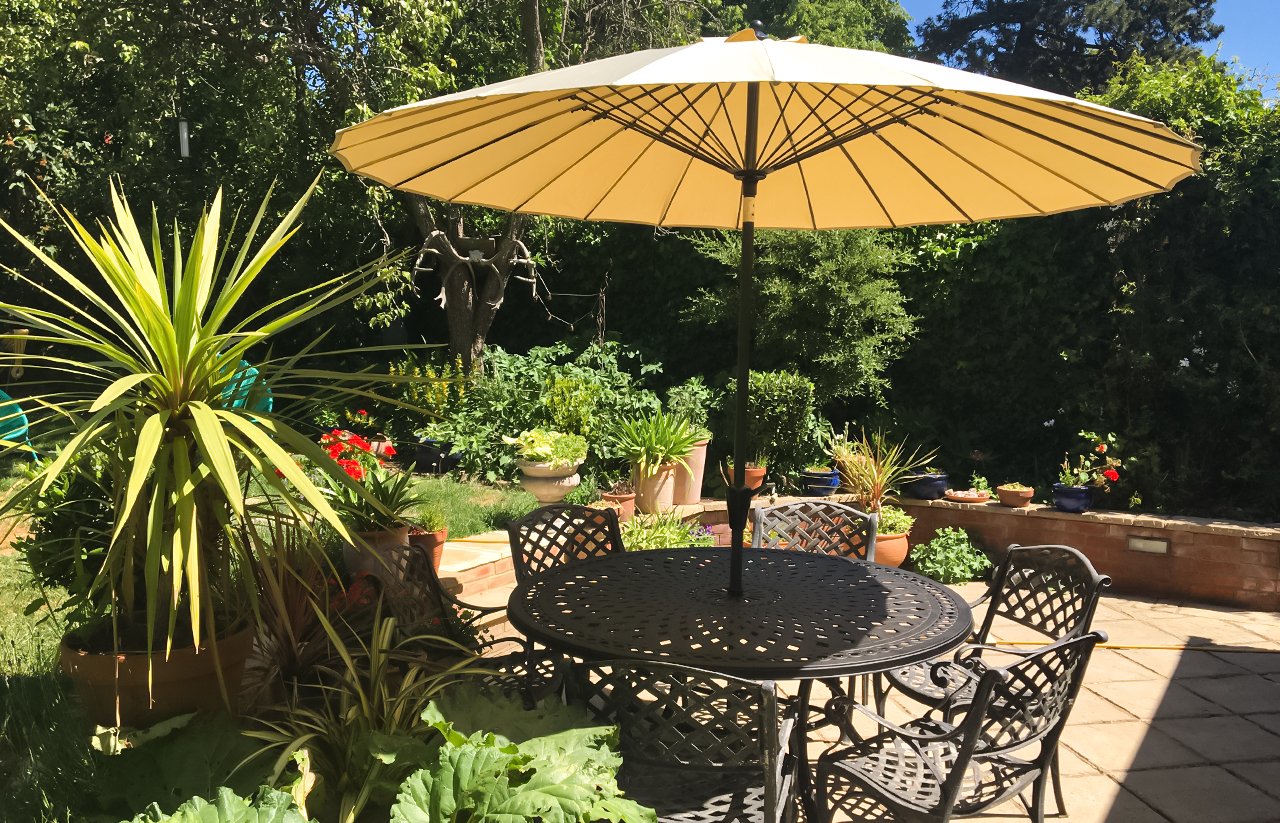Mould is the scourge of outdoor fabrics. We've just got that climate here in the UK where you leave a parasol or cushions in the garden, a bit of rain, a bit of sun, and hey presto... Mould spots!
However, don't despair, you can clean mould off outdoor fabrics with a few items we've all got in our cupboards. No need to buy any expensive solutions or replace them with new ones.
Here at Lazy Susan, our speciality is Metal Garden Furniture, and whilst it is comfortable to sit on as is, garden cushions and a parasol will ensure you can enjoy it when things heat up in summer.
Outdoor fabrics such as those found on our garden cushions and parasols can develop mould or mildew stains when left outside. Quicker you'd think too!
One of the Lazy Susan team went on holiday for a fortnight, in the so-called British summer, accidentally leaving the cushions on a rattan sofa set. Came back to several patches of mould that had appeared from nowhere.
That rattan sofa has since been replaced but that is another story, back to mould. It is defined on Wikipedia as:
“A fungus that grows in the form of multicellular filaments called hyphae.”
There are thousands of different species of mould but most of them lead to one thing on outdoor fabrics… Unsightly stains or marks.
Mildew on the other hand is a form of fungus. Although closely related to mould it is distinguished from mould by its colour.
Mould can appear in a variety of colours depending on the species. It could be black, blue, red, or green, whereas mildew is white.
However, what they both have in common is that they’re unsightly, and a little on the smelly side. If they appear on your outdoor fabrics, you want rid of them.
The good thing is that they’re often easier to remove than you think. The key is to deal with the problem when you see it forming. and not leave it to take hold.
The term mildew is often used generically to refer to mould growth, but be it mould or mildew, they can be cleaned in the same way.
Outdoor Furniture Cushions
At the end of the day, mould and mildew are unsightly. We keep using that word, but let’s face it, nobody wants to sit on mouldy cushions.
The cushions on that rattan sofa set were white too, so it stood out like a sore thumb. Patches of black spots.
As we mentioned above, the key to treating mould stains is to get them cleaned off as soon as you see them starting to form.
Don’t give it a chance to take hold, if those stains are left too long, they can be a little trickier to remove, especially on lighter-coloured outdoor fabrics.
Many of us are now popping our outdoor cushions away for the winter, so you must make sure they're mould-free before you do this.
If they aren't cleaned now they'll become permanent and your only option might be to replace them.
To clean mould and mildew off cushions, the simple Lazy Susan method is as follows:
- Start bet getting a bucket, and filling it with warm water.
- Add ½ a cup of white vinegar and ½ a cup of an in-wash stain remover.
- Give it a good mix until everything is dissolved.
- Take a soft-bristled brush (an old nail brush is ideal), and gently scrub the mould stains.
- Always test a hidden area before you start though, just to make sure it doesn't damage the fabric in any way.
- If like our cushion covers, they can be removed from the seat pad, pop them in the wash on a 30-degree gentle cycle
- Rinse with cold water and leave to dry flat.
- If necessary, repeat the process
If the stains are a little on the stubborn side, you can also apply a little lemon juice and the stain-removing powder directly onto the stain with a few drops of water. Leave it to fizz for a few minutes and then repeat the steps above.
Garden Parasols
The parasol is another item that can easily develop mould and mildew, and again many of us have or will be soon popping them and our Metal Garden Furniture away for the winter.
Another culprit is popping it in its cover when still a little damp, so always make sure you store it dry.
Not as easy to tackle as the cushions due to size. You definitely can't pop it in the washing machine. You should always clean the fabric on the frame and never try to take it off.
It is best done with the parasol up and opened so the fabric is tight. Pop it in the base and drop it down as low as you need it. Our garden parasols can be angled too so I’ll tilt when rinsing.
The best way I’ve found to clean mildew and mould from a parasol is with the following (non-bleach) method as it doesn't damage the canvas.
But again, test in a small inconspicuous place before cleaning the full parasol. I know this is tricky but I would say where a spoke joins seam is your best bet.
- Bursh
WiStart by giving the canvas a good scrub with a soft-bristle brush just to remove any loose dirt. - Wash
Then give it a wipe with a little warm water to soften and break up any bird droppings, tree sap, etc. - Mix
Pop on a pair of rubber gloves, half fill a bucket with water and add ½ a litre of White Spirit, which you can pick up from the paint section of any DIY store. - Scrub
Give it a good stir and then with a soft cloth (rubber gloves still on) and all the excess liquid squeezed out, give the fabric a good scrub. This will break up and gently remove any mould spots. - Rinse
When all is gone, rinse the fabric with a garden hose. It's a little smelly so be sure you give the whole thing a good rinse. - Dry
Pat it dry with an old tea towel, and then leave it to fully dry in the sun.
You and use this method on cushions too, but I would only advise you to do it if the covers can be removed and then washed in the washing machine. You don't want the white spirit soaking into foam where it will be difficult to rinse off!
And just remember that your parasol and outdoor cushions should never be put away damp. They also need to be stored in a dry place with good ventilation as this will help to prevent any future mould from forming.
Mould & Mildew Prevention
As the old saying goes - "prevention is better than the cure" - but I’m afraid this isn’t a job you can easily do with what’s in your cupboards, you need a specialist outdoor fabric protection spray.
There are many brands on the market, so have a shop around. Many might be sold for use on tents and awnings for example, but they’ll often do the same job on a parasol or garden cushion.
You want something that will not only reduce the likelihood of mould and mildew taking hold, but the good ones will also repel moisture and protect the fabrics from sun/UV fading.
One name you can always trust with this type of thing is Scotchgard™. They have a spray Water & Sun Shield protector that is ideal for garden cushions and parasols.
It is easy to apply, designed to reduce colour fading and helps protect (or at least minimise the chance) your outdoor fabrics from mould and mildew by making it easier for moisture to bead and run off.
That also means it offers good water and stain resistance, so everyday spills disappear in a snap.
Other than that, just keep those outdoor fabrics clean. If they do get caught in the rain, dry them off, and never store them damp!





